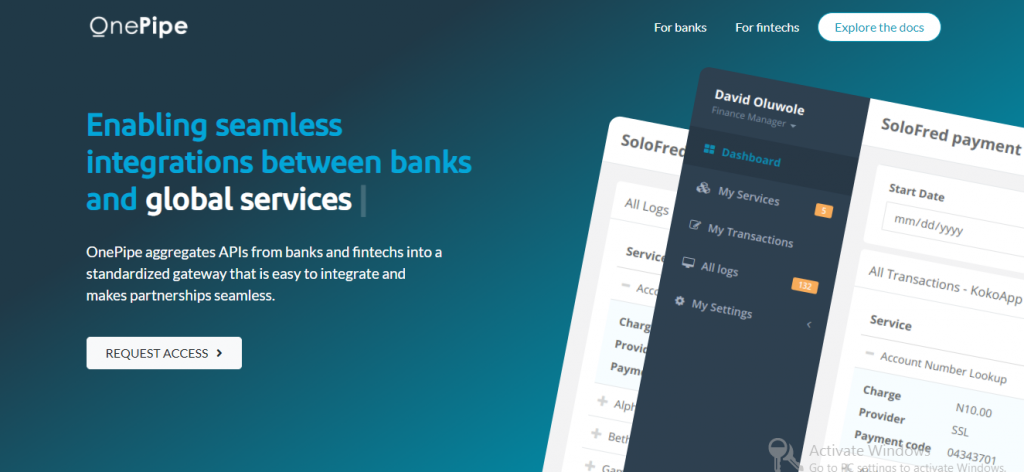You have a shop in the neighbourhood or market, selling things like milk, noodles, sugar, etc. Now imagine that your plug for Nestle, Unilever or Flours Mill of Nigeria (FMN) products provides you with a special bank account. “That’s absurd, why?” You say. Let’s take a step back a little…
This distributor has probably done business with you for five, ten years or more, knows your business, your purchase, sales and payment patterns, and can, in fact, offer financial services better suited to your business.
This is because they know more about you than perhaps the big-name bank you use down the road. For example, when you need to expand your business from one to two shops, your bank is unable to give you the loan to help you do that because, frankly, it can’t tell whether or not you are into what you claim is your business.


Your bank statement does not contain enough information about your business to help them decide and they don’t know what you sell daily, weekly, etc. Or the margins you get on each supply you receive and sell. But, your distributor provides you goods, maybe weekly or even daily, knows the volumes you move and how promptly or not you make payments. Also know the margins in each product. Just like you, they know the business.
If the distributor could finance you to grow your business, you will buy more from him. And sell more. And she in turn will pull more volume from Nestle, P&G, etc. Win-win-win for everyone.
The spoiler? That distributor is not a bank and can hardly do more than give you goods on credit, occasionally.She definitely doesn’t have the liquidity to cater to all of your growth needs.
That’s where embedded finance comes in.
A Forbes article describes embedded finance as “the use of financial tools or services — such as lending or payment processing — by a non-financial provider,” and expanding this, the end goal is to offer customers a payment experience that is likely to keep them loyal and continue doing business through that platform.
Here are four ways the FMCG industry can utilise embedded finance, to offer financial services throughout their supply chain, without having to grow through the overhead of becoming banks themselves.
Credit line to keep goods moving
The supply chain as of today is mostly analogue and it is hard to accurately know in micro details, what role every participant has played. To be clear, a manufacturer or distributor would have records of how much inventory is sold or not, but does it know what moved across different categories of distributors and down to retailers? Not likely. And definitely, not accurately.
Digitizing the workflow creates an integrated ecosystem in which every player becomes visible in the supply chain. This is especially important for players closer to the bottom of the chain, many of whom the FMCG manufacturers would have no direct records of, yet are active participants in getting goods down the last mile and to consumers.


Many of these could rely on physical bookkeeping to track their finances, but when they need a credit line for goods from the same company, showing a track record becomes challenging. Even worse when they buy their inventory through layers and layers of middlemen and sales agents.
A finbox article emphasised that:
“The digital integration of smaller distributors and local stores through payment solutions, accounting apps, and banking solutions will generate standardized data on transactions within the chain, leading to increased transparency at every stage – tracking goods, inventory management, and sales.”
In essence, offering digital tools that help a retailer to spend, receive and track their money – embedded finance, could allow a 3rd party (or even a bank) have the visibility and confidence to step in to offer credit lines that support the retailer with goods or services (as the case may be), based on their transaction history, which would have been recorded on the platform.
In a practical sense:
If a shop owner usually buys N20,000 worth of inventory every week, consistently, and a bank or lender has visibility into this, they are able to step in to help increase the basket size to N30,000.
Needless to say, the more goods the retailer is able to sell, the more the FMCG distributor or manufacturer itself stands to make. With embedded finance – inserting the services of the bank or lender into the (now digital) exchanges between retailer and distributor, we are now able to determine based on transactions; who is qualified for what level of the credit line?
It becomes possible to have data-driven decision making that keeps retailers in business and possibly expanding, and invariably, the company at the top of this chain keeps winning.


Insurance on sales
Insurance is often overlooked in this part of the world and when offered to people, it is not unusual to hear; ‘loss is not my portion’. Yet, losses occur, and perhaps more frequently than many would like to admit.
However, there are instances where insurance is not optional, especially for the transnational movement of goods.
As part of the supply chain experience, insurance protection can be embedded within the solution offered by the FMCG manufacturer or distributor. As usual, an insurance provider needs historical data to determine risk and price it appropriately. The digitization effort creates this trail and makes this possible.
In practical terms: It’s not uncommon for drivers of delivery vans to drive off with goods and cash. Or get waylaid by urchins. Embedded insurance protects against this possibility. But requires digitization to be effective.
There are even more interesting insurance products that can be designed: Imagine a retailer getting money back for inventory they were unable to sell due to external factors? Yes, possible.
A financial bouquet to do more
The account number that ties any dealer in the supply chain to the embedded finance solution, can also be used for any regular banking service. So, when the delivery of Indomie Noodles comes from Dufil and the distributor needs to pay the haulage company, they are able to do so through the embedded finance solution provided by Dufil.
They would not need to log into a separate bank account, then make a transfer, or worse still, hand over a wad of cash. Payment for warehouses, store rent, utilities and even salaries of employees can be done from that account provided by the FMCG company.
A distributor can make all business-related expenses from that single account, making it easy to accurately determine what costs are associated with that business, and how profitable or not it has been.


The good part of this? Because the account is provided by the FMCG company or Distributor, they usually have negotiated “corporate pricing” with the bank or financial service providers… and because they are not in this to make money from banking services, per se, they are able to pass those gains down to the retailer in the form of cheaper services, etc.
Imagine sending money for less or buying airtime at a discount because the margins of the bank have been passed to the retailer in the form of incentives.
Integrated payment experiences to eliminate cash
Every distributor and manufacturer knows that cash handling is a big problem and cost. The retailer receives cash from their own customers. The retailer pays the wholesaler or distributor in cash.
Everyone has to count, reconcile and move that cash around. Someone pays for the insurance on that cash, someone pays the cashless penalty on that cash, Etc. With an embedded bank account, the distributor can in one click take payments from the account of the retailer when the time comes to pay.
With an embedded account, customers can pay directly into the account of the retailer versus cash. And these days, they can do that with either cards or transfers.
And the incentive for the Retailer to push this? Every inflow and outflow from that account helps him to create the required data trail through which he can get the credit line with which he can start his 2nd shop or buy more inventory. An unending hamster wheel of growth..
In conclusion
Embedded finance solutions are ready for deployment within days and do not require building from scratch. OnePipe makes it possible for non-financial institutions like FMCG manufacturers and distributors, to offer financial services without becoming fully-fledged providers.


From facilitating credit to offering investment possibilities, each possibility is in itself a full-time job, with requirements varying from tech to operations, regulation, dealing with things like fraud, compliance etc, yet, possible to offer as a single suite through embedded finance. The experiences for customers keep them integral in the supply chain and implementing FMCG expands revenue without ‘investing heavily in the tech to achieve this.
What is there not to love about embedded finance?
This article was written by Ope Adeoye, Chief Plumber, One Pipe.






